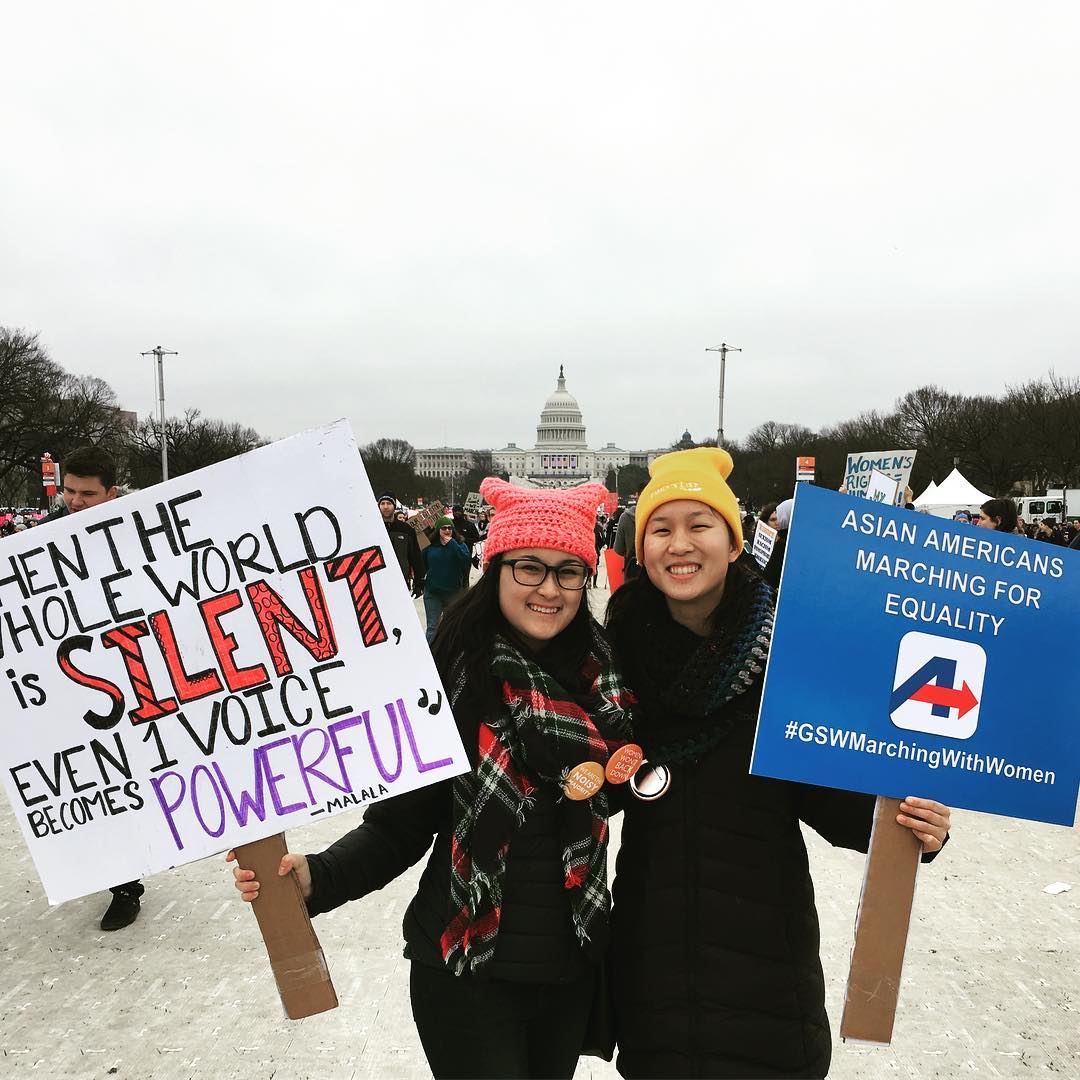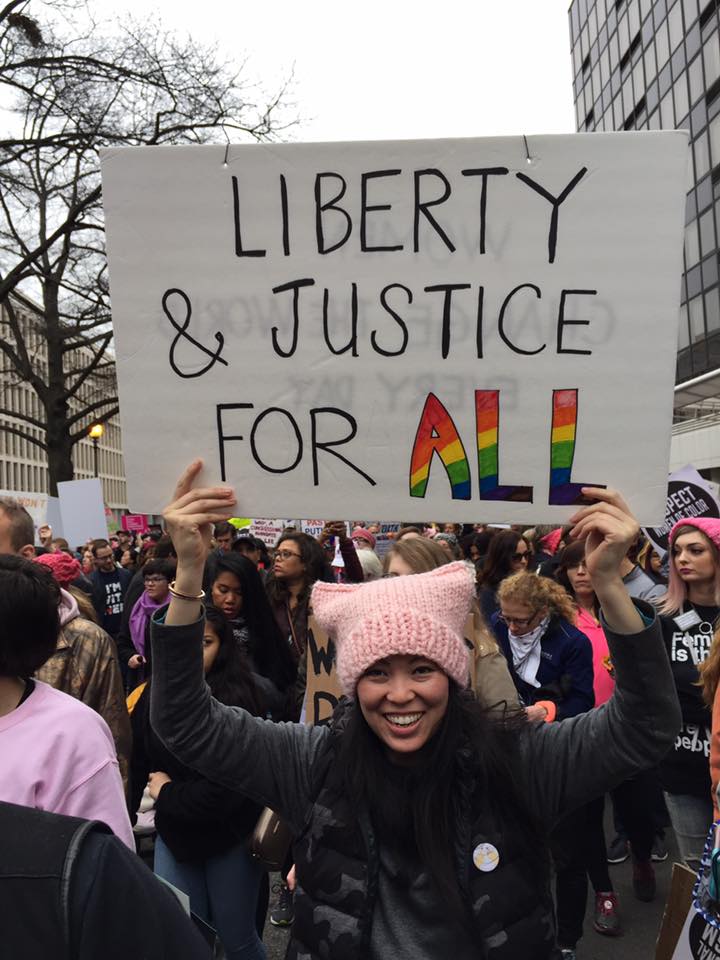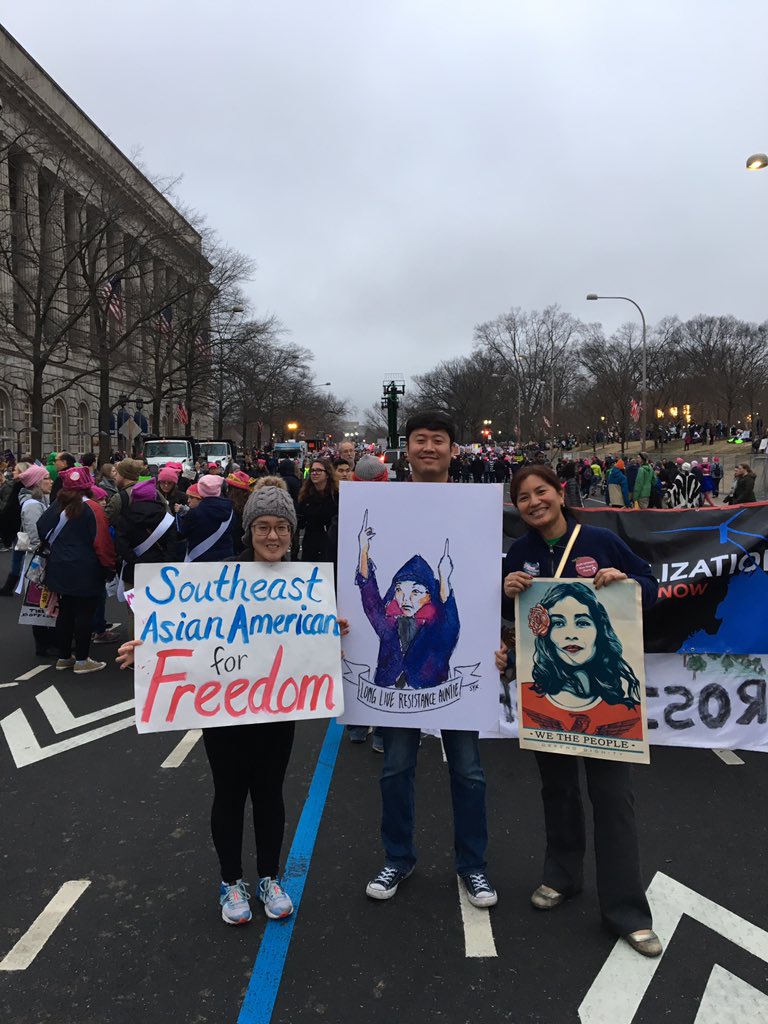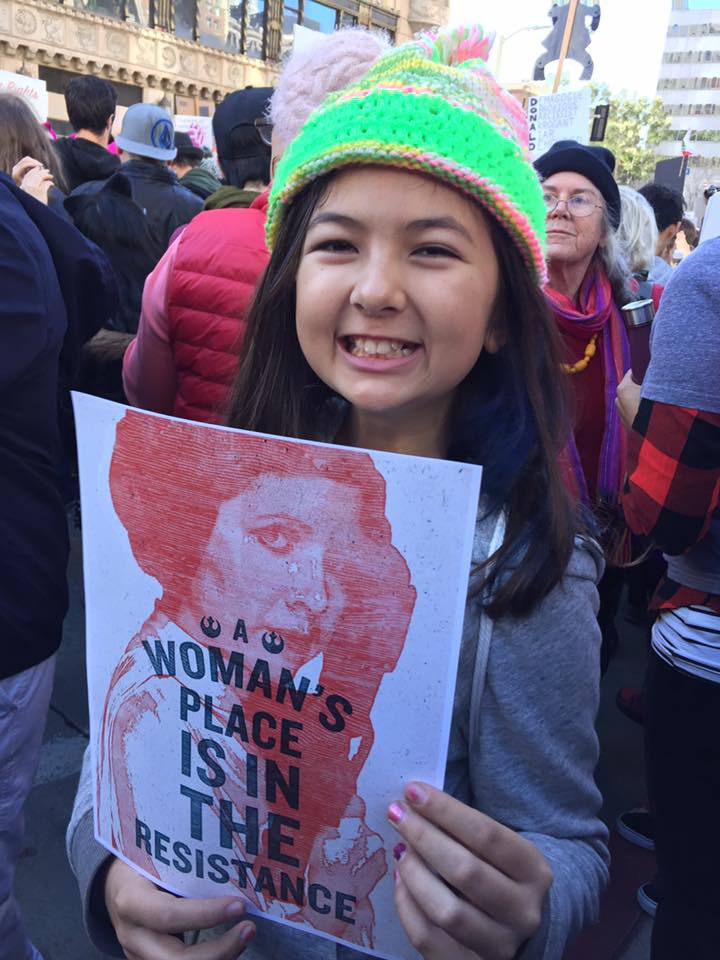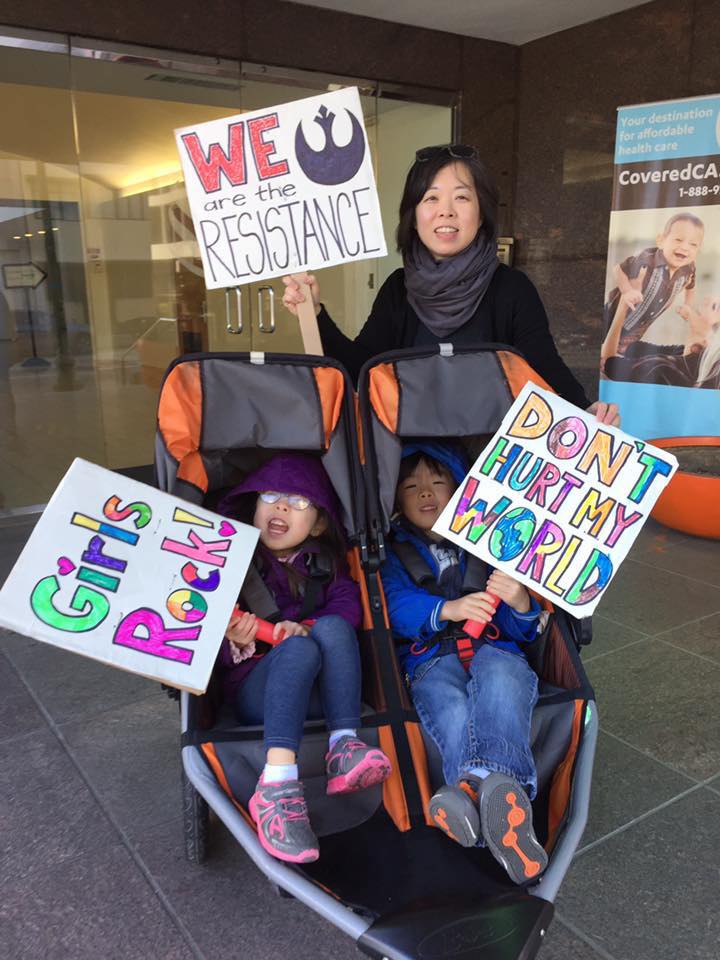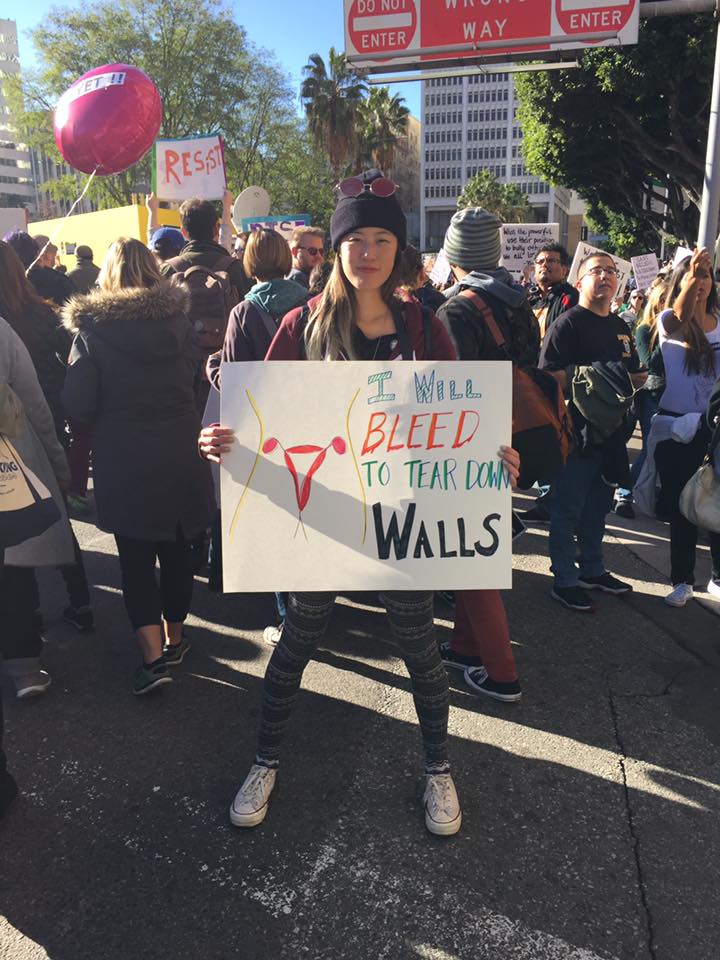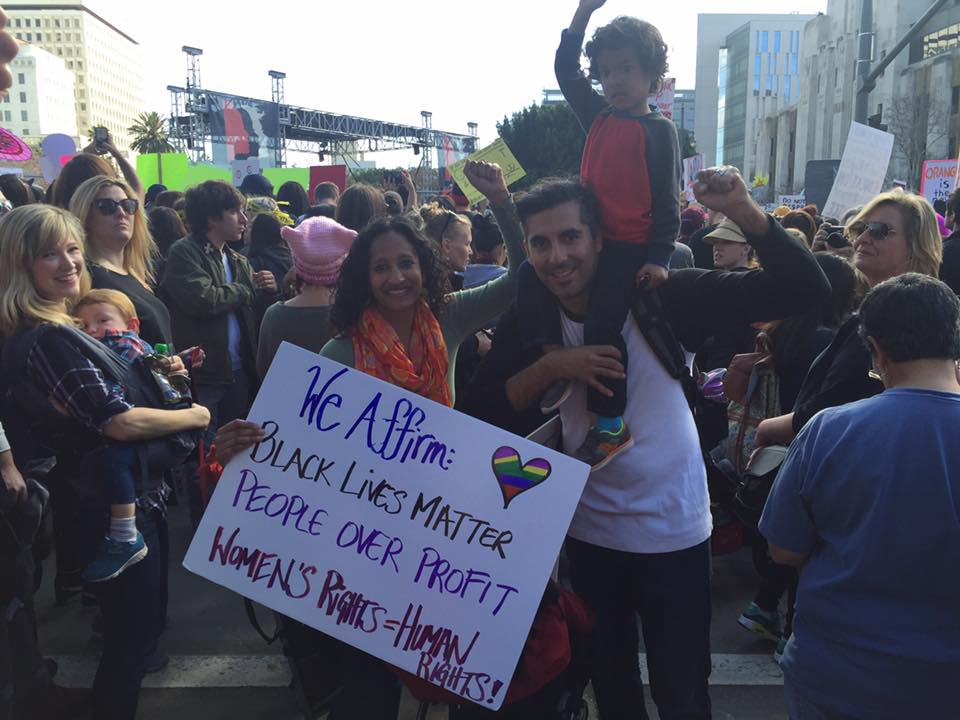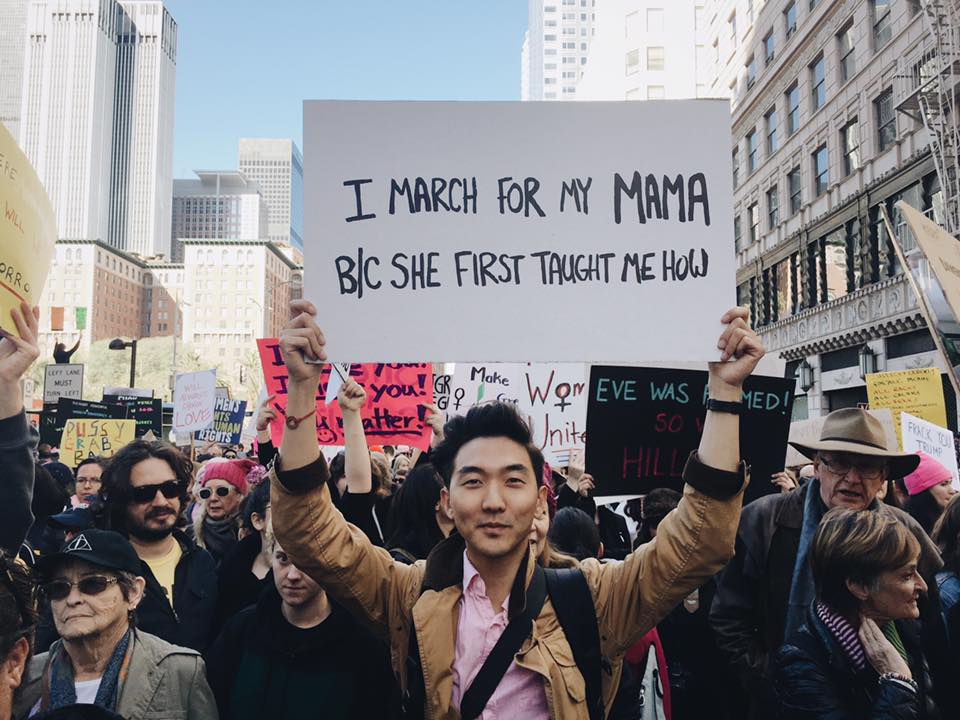Tune in to issues around the nation and get the scoop on Stanford activism! Our monthly newsletter highlights current developments in politics, culture and entertainment of interest to the Asian American & Pacific Islander community.
CONTENT [* = Take Action!]
Letter from the Editors
Lunar New Year*
Ban on Immigrants & Refugees*
Stanford Community’s Response*
Other Updates from the Farm
National Politics: Activism, the Inauguration & Resistance*
Trafficking in Asian Stereotypes*
Sports and Pop Culture*
Literature and Art*
Your Stories*
I. Letter from the Editors
Dear SAPAAC Community,
This is a challenging time for communities across America. With the administration's Executive Order to bar non-citizens from seven countries (including refugees, legal visa-holders and initially even United States permanent residents), the targeting of persons based on national origin seems to be the rule of the day. This strategy is quite possibly being used as a proxy for ethnicity, race, or religion. At the very least, it seems to be politically messaging as such.
Public demonstrations and court challenges have begun, including major stands by protestors at SFO, LAX and JFK airports. Federal judges have ordered stays on elements of the Executive Order. A multitude of citizens, companies, and lawmakers have been speaking out in defense of freedom and tolerance, and affirming that people of all backgrounds, including Muslims, are welcome in America, which is a country of immigrants. Yet this is only the beginning of a long struggle.
The fantastically diverse student body at Stanford University has already been affected. Graduate students returned early from overseas to avoid being barred from entry, and one student was handcuffed and detained for several hours upon arriving in the United States. As an organization representing the Asian American and Pacific Islander alumni of Stanford University, SAPAAC expresses its solidarity with all affected communities, within the university and the public at large. Many of us are sons, daughters, and descendants of immigrants and refugees—or newly arrived to the United States ourselves.
Throughout our country’s history, the AAPI community has been buffeted by changing tides either welcoming or excluding immigrants. Much as the Executive Order does today, the Chinese Exclusion Act of 1882 barred whole classes of immigrants, even though Chinese workers had been instrumental to the construction of the Transcontinental Railroad that knitted America together—and in the process, secured Leland Stanford’s fortune. American citizens and residents of Japanese ancestry were uprooted from their lives in 1942 and forced into internment camps, solely based on their race. (Fred Korematsu Day on January 30 celebrates a civil rights campaigner who resisted this order.)
Yet the 1965 liberalization of immigration policy represented a break with the discrimination of the past. Subsequent waves of arrivals, including the Vietnamese impacted by war in the 1970s, have shown how new communities can integrate into American life, participate in the democratic system, and enrich our economic, linguistic and cultural lives.
In 2017, in the face of this test of our democratic resolve, staying silent indicates complacency—perhaps even complicity—about the choices our government makes. It is of utmost importance that each one of us find a way to respond with action. What does it mean to take action? We can contact our government representatives. We can directly assist those in need. We can share true facts and figures. We can run for public office to represent our community and its values. We can educate our own families, friends, and professional circles about current issues and historical wrongdoings, as a Japanese American civic leader does in this moving essay.
For SAPAAC, we hope to highlight pathways for our membership to respond, resist, and make change. In this issue of the Asian American Newsletter, we feature the usual roundup of national and Stanford news related to the AAPI community. You will also notice that in several areas, we include opportunities for you to act, labeled ACTION.
If you have any additional stories you wish to see included in future newsletters or suggestions for discrete actions that SAPAAC members might take, we welcome you to share them with us! Please write to the Issues & Advocacy Committee with your ideas.
A healthy democratic culture exists when we pay attention, actively participate, and show solidarity to communities whose rights are being targeted. In tough times, please stay encouraged and stand together.
In solidarity,
The Executive Board of the Stanford Asian Pacific American Alumni Club (SAPAAC)
II. Lunar New Year
Happy Lunar New Year! Many people in Vietnam, Korea, Taiwan, Mongolia, China—and their many overseas diaspora communities—celebrated the holiday on January 28 and 29. Read an Asian grandmother’s instructions for how to prepare for the Year of the Rooster and if you’re in California, watch San Francisco’s famed Chinese Parade to culminate the festivities. SAPAAC members in Seattle, Washington celebrated at one of the best dim sum restaurants on the Eastside, while those in London enjoyed a Vietnamese Tet Lunar New Year lunch. Bay Area residents taste-tested teas in Berkeley.
In 2016 (according to the Gregorian calendar) or the Year of the Monkey (by the lunar calendar), Asian Americans broke new ground in the arts, culture, and politics with more Asian American legislators than ever before representing the country in the 115th Congress. However, Asian Americans are not well represented in the judicial branch of government: despite there being numerous Asian American attorneys, there are remarkably few AAPI judges: only 3% of the federal judiciary and 2% of state trial and appeals judges. The study, published by California Supreme Court Justice Goodwin Liu and a group of students at Yale Law School, also found that only 3 out of 94 federal attorneys and 4 out of 2,5000 elected state prosecutors were of AAPI heritage.
ACTION: Justice Goodwin Liu, a Taiwanese American, will be one of the featured keynote speakers at the first-ever Stanford Asian Pacific American Alumni Summit from March 31-April 2.
Register before February 15 for this historic experience and save $75!
Another noteworthy January holiday: Korean American Day, first declared on January 13, 2003. It commemorates the arrival of Korean immigrants who settled in the United States in 1903.
III. Ban on Immigrants, Refugees and Visitors
The Executive Order banning immigrants, refugees, and travelers from seven countries struck close to home: a Stanford student was detained at the airport, and as the Stanford Daily reports, international students—including those with Iranian, Yemeni and Sudanese citizenship—are at risk. The university’s leadership issued a letter to “reiterate our community values. As an academic institution with students and scholars from around the world, Stanford values and in fact depends upon the flow of students, educators and researchers across borders.”
Bay Area companies voiced strong disapproval because “just about everyone in Silicon Valley came from somewhere else or is a son or daughter of someone who did or is married to someone who did.” Stanford alum and Google co-founder Sergey Brin joined many Bay Area citizens in protest at SFO, mirroring protests in other airports across the country. From Chicago to Washington D.C., hundreds of attorneys showed up at airports to help immigrants and other travelers being detained. Many Asian Americans also took part in other demonstrations.
For Chinese Americans, the Muslim ban is a reminder of decades of discrimination, exemplified by the Chinese Exclusion Act of 1882. Japanese Americans have also been deeply disturbed by the parallels with their experience. The American Civil Liberties Union argues that “the incarceration of Japanese Americans in World War II does not provide legal cover for a Muslim registry.”
In a related event, SAPAAC members toured a new exhibit at the Chinese Historical Society of America (CHSA) highlighting the discriminatory laws that limited Chinese immigration and forced photographic identity cards onto the population. After the tour, Doug Chan ’76, a CHSA board member and practicing lawyer, answered questions about the Chinatown museum over pearl milk tea. Mentioning a few civil rights cases, Chan said, “Everything that’s happening now [with the Muslim ban]—it’s not new, because it also happened to us.”
Fears are rising that anti-foreigner sentiment could bleed over into other areas of public life. Public anti-Asian hate crimes have been reported in Los Angeles and on the Columbia University campus.
ACTION ITEMS
When we are shocked by the direction the government is steering the nation, it is important to take action to defend our core values and beliefs.
1. If you disagree with government policies, call your members of Congress, including your representative in the House and your two Senators. This is a proven strategy for expressing your views and more effective than tweets or online petitions. For even greater impact, pay a visit to a Congressional district office in person, as Christine Su ’08, MS ’15, MBA ’15 and a group of her friends and colleagues did. Learn about influencing Congress and changing government policies in the Indivisible Guide, crafted by former Congressional staffers.
2. If you are concerned about civil rights being undermined, donate to the American Civil Liberties Union. The ACLU filed a lawsuit against the ban which resulted in a stay being issued for travelers with legal visas. Find more information on donating at the ACLU website.
3. If you feel inclined to promote tolerance and highlight the lessons of history, educate your community about how America wrongfully treated minority populations in the past. An essay and video from Densho, an organization whose mission is to “preserve the testimonies of Japanese Americans who were unjustly incarcerated during World War II before their memories are extinguished,” provide a great resource to start.
4. If you want to help refugees integrate into your community, look up local agencies providing services and support or volunteer with them. Canada has experienced an upwelling of outreach to immigrants and many offers to host refugee families. In the United States, more info is available through Refugee Council USA, a coalition of 22 NGOs and through the State Department’s list of refugee processing affiliates. You can also learn more about global refugee issues through UNHCR, the United Nations Refugee Agency.
5. If you want to show solidarity as a community, encourage Asian American organizations and other civic organizations you are a member of to make public statements about our shared ideals and values. The Stanford Asian American Activism Committee (SAAAC), a student group, signed on to a public statement pledging to resist undemocratic or inhumane policies emanating from the White House. Over 100 AAPI organizations nation have already signed a “letter of resistance” which states, “As Asian Americans and Pacific Islanders (AAPIs) committed to equality, inclusion, and justice, we pledge to resist any efforts by President-Elect Trump’s administration to target and exploit communities, to strip people of their fundamental rights and access to essential services, and to use rhetoric and policies that divide the American people and endanger the world.”
IV. Stanford Community’s Response to the Ban on Immigrants, Refugees and Visitors
Stanford University has responded to the immigration ban in several ways. First, international students traveling overseas were notified by their departments to return home as soon as possible to avoid the fallout. The Bechtel International Center hosted several public events, including a session for students directly impacted by the ban and another session for the whole Stanford community.
The Stanford Daily reports that students organized a demonstration on White Plaza, while “faculty affiliated with the Jewish Studies program have also issued an open statement condemning the executive order directly, calling it a ‘scandal to our democratic culture’ and suggesting that its release on Holocaust Memorial Day made the rejection of refugees particularly egregious.”
The Asian American Graduate Student Association (AAGSA) wrote a letter to its membership and then published an op-ed in the Stanford Daily decrying the ban, proclaiming that “a threat to any immigrant is a threat to all immigrants and to their descendants.” Anthropology Ph.D. Nisrin Elamin, who was detained at JFK Airport in New York, shares her story in an interview and speaks out against the ban.
University President Marc Tessier-Lavigne later joined “47 other college and university presidents in a Feb. 2 letter to President Donald Trump regarding the executive order” and made remarks to the Faculty Senate on the issue.
ACTION: Everyone has certain rights under the Constitution, whether a citizen or non-citizen. Learn about your rights and share with friends and family members (in multiple languages), including how to respond to immigration enforcement officials. Additional resources and hotlines are available here.
V. Other Updates from the Farm
In one of his last acts before stepping down, Provost John Etchemendy relented and gave the Stanford band a reprieve, suggesting that the student-run organization is committed to reform and so will not be suspended in the coming year. On February 1, Etchemendy was succeeded as university provost by Persis Drell, the dean of the School of Engineering and former director of SLAC, the Stanford Linear Accelerator Center.
As Stanford University pursues the update of its General Use Permit from Santa Clara County, which regulates the expansion, growth and development of the campus, a group of students called for more consideration of social equity issues related to land use. Stay tuned to this issue, as it will influence how the university expands over the coming decade.
VI. National Politics: Activism, Inauguration & Resistance
ALBUM: A sample of photos from "When Angry Asian America Showed up to March," a photo album from the Women's March, posted on the activist blog Angry Asian Man.
As President Obama’s second term came to an end, many commentators reflected on what his historic presidency meant, including a slate of Asian American civic leaders. One op-ed argues that he could be seen as “the first Asian American president” because “along with this sense of interconnected struggle was the mere fact that Obama acknowledged ‘Asian-America’ at all. In politics, the bar to engage the Asian-American community is low, because it isn’t seen as a decisive factor in electoral outcomes. And yet in Obama’s victory speech in ’08, he included Asians in a recitation of the complex American demography that had voted him into office.”
The inauguration of Donald Trump sparked concern in the Asian American community, whose concerns were borne out days later by the Executive Order deeply threatening to immigrants and refugees. California Congressman Mark Takano, who is of Japanese ancestry and whose parents and grandparents were jailed in internment camps, detailed in an open letter why he would not attend the inauguration. “The next President of the United States cannot effectively lead this country with only a legal and technical victory in the Electoral College. He needs moral and ethical assets as well. These are not purchased through the art of the deal, but earned through words and deeds that subordinate personal gain for the advancement of freedom and equality.”
On the other side of the political aisle, the Trump-Pence Asian Pacific American Advisory Committee (APAAC) and the National Committee of Asian American Republicans (Asian.GOP) decided to host an “Asian Pacific American Presidential Inaugural Gala 2017” which included among its goals, “celebration with prominent dignitaries and Presidential appointees” and “networking interactions with business elites in the Asian American and Pacific Islander community.”
Overall, Asian Americans heavily favored Clinton over Trump, at rates of 65% to 75%, based on exit polls and other election surveys. Despite historical support for the GOP based on anti-communist and small business views, Asian Americans are now “identifying as Democrats at a quicker pace than any other racial group,” according to The New York Times.
The Women’s March on Washington the day after the inauguration, and the many parallel protests around the country, appeared to be the largest demonstration to ever take place on U.S. soil. Over 3 million people took to the streets to demonstrate against the policies and rhetoric espoused by the new Trump administration. Many AAPI citizens were part of this action, coming together with other Americans of diverse backgrounds. View an extraordinary album of photos submitted by AAPI demonstrators on the Angry Asian Man blog.
Lawmaker Stephanie Murphy (D-Florida), the first Vietnamese American woman elected to Congress (herself a refugee who had journeyed to the United States with her family), filed legislation to block Trump's top political advisor Steve Bannon from joining the National Security Council (NSC). Trump created a major uproar when he sought to elevate Bannon, who has little national security experience, while demoting the head of the Joint Chiefs of Staff and the Director of National Intelligence, from permanent to non-permanent NSC members. Stanford political scientist, Michael McFaul, also the former ambassador to Russia, explains the issue. California Senator Kamala Harris, who is Indian American and African American, co-sponsored a bill in the Senate to formalize NSC membership and prevent purely political advisors from obtaining permanent seats on one of the country’s most important bodies dealing with security issues.
An Indian-American bitcoin entrepreneur could potentially head the Food & Drug Administration (FDA). Stanford alumnus Balaji Srinivasan (‘01, PhD ‘06) is on Trump’s short list for candidates, although his candidacy has proven somewhat controversial. Seema Verma, also an Indian American, was appointed Administrator of the Centers for Medicare and Medicaid Services.
In a commentary published in the New York Times, entitled “What Trump Taught Me About Being Asian-American,” journalist Stephanie Siu discusses her personal transformation. “Growing up in Manhattan, the American-born child of immigrants from Hong Kong, I was embarrassed by my family’s strange holidays,” she writes. But thanks to a sojourn through Asia and spurred on by the darkening political climate, Siu comes to realize that “belonging is personal, fluid and multicultural.” Though she had previously “clung to being an American as my one immutable identity,” she now feels that “being Asian [does] not make me less American.”
Washington Post journalist Doris Truong was mistakenly accused of taking photos of Rex Tillerson’s notes during his confirmation hearing to be Secretary of State. Truong faced Internet harassment because an individual of Asian appearance was seen taking photos from the gallery during the hearings. Internet “trolls” decided to label the photos with Truong’s name because she was a journalist who happened to also be Asian. In another confirmation hearing, Senator Jeff Sessions’ Asian American granddaughters were the target of racial insults on Twitter.
Of interest to activists, a report entitled "A Growing Voice: Asian American Voters in North Carolina” discusses the fastest-growing racial demographic in the state, which also reflect changing conditions in the country. A writer discusses the challenges of navigating Asian American Christian churches and her own views as a religious person and a liberal.
ACTION: Asian Americans have lagged Latinos and Blacks in levels of voter registration, due to language and cultural barriers. Get involved in voter registration efforts with special outreach to the Asian American and Pacific Islander population such as APIA Vote, a “national nonpartisan organization that works with partners to mobilize Asian Americans and Pacific Islanders in electoral and civic participation.”
VII. Trafficking in Asian Stereotypes
A Harvard Business Review article asks: “Why Aren’t There More Asian Americans in Leadership Positions?” It explores the role of stereotypes and cultural values inhibiting the rise of Asian Americans as executives in the business world. Another example of stereotyping hurting Asian Americans’ careers is the case of a Korean-born political science professor who is suing the University of Illinois at Chicago for discrimination. The department allegedly forced him to teach statistics, which is not his specialty, because they felt that “Asians, especially Koreans are very good at mathematics and statistics.”
ACTION: A panel on breaking through the “bamboo ceiling” will also feature at the Asian Pacific American Alumni Summit.
Register by February 15 for early bird pricing and save $75 at http://www.sapaac.org/summit
In another example of stereotyping Asians, comedian Steve Harvey targeted Asian American males as the butt of a joke, trafficking in the false idea that they are less-than-masculine or undateable. Eddie Huang, the Taiwanese American whose biography is the basis of the popular television series “Fresh Off The Boat” (an episode in Season 3 also celebrated the Lunar New Year) wrote a scathing response in The New York Times. Harvey later apologized. Kind of.
A feature in The New York Times describes how Bruce Lee exploded stereotypes in Hollywood. At the time, “Asian men were often cast as servants, deviants or as wily and desexualized.” (If they were portrayed at all.) Lee decided to reject such typecasting and create new roles. Award-winning playwright David Henry Hwang ‘79, who wrote a play about Bruce Lee’s life, is quoted in the article, describing Lee as the “first Asian man to manifest all of the conventional American movie markers of masculinity. ‘He creates a new archetype in the West...the Asian-American male hero.’”
Gay Korean American actor and comedian Peter Kim suggests in a video commentary that aired on the Newshour on PBS, a national news program, that “white supremacy” can be defined as “the commonplace cultural assumption that white is the default race in America.” He discusses the challenges faced by people of other races, including those in the queer community, and the problems with this cognitive framing. In a related vein, David Yi writes, “As an Asian American, I am Invisible in this Country.”
ACTION: Buy a calendar featuring Asian men defying stereotypes. Two options are “The New Asian Men 2017 Calendar” and “Haikus on Hotties,” which was featured on NBC last December.
The error of stereotyping also applies to economic issues. The Asian American bloc is extremely diverse, not monolithic, and a recent report finds that the “Asian-American Wealth Inequality Gap” is actually widening.
Professor Xiaoxing Xi of Temple University, supported by Asian Americans Advancing Justice, has “embarked on a tour of California to raise awareness of the Scientists Not Spies campaign,” which seeks justice for Chinese American scientists falsely accused of spying for China. Xi suffered from the erroneous 2015 accusation until he was exonerated eight months later, and all charges were dropped by federal prosecutors.
VIII. Sports, Entertainment & Pop Culture
Asian Americans dominated the 2017 U.S. Figure Skating Championships, taking home gold in three of the four main events. Karen Chen, age 17, won the women’s title. Male figure skater Nathan Chen “landed a staggering five quadruple jumps on his way to claiming his first U.S. title. At age 17, he is the youngest U.S. men's champion in 51 years.” He also achieved a record high score. Another Chinese American skater, 16-year-old Vincent Zhou came in “a distant second.” Brother and sister Maia and Alex Shibutani won a second consecutive national title in ice dancing. There is plenty of talk of the 2018 Winter Olympics to be held in Pyeongchang, South Korea. Nathan Chen was featured in an NBC story. Karen Chen is a hometown favorite from Fremont, recently profiled by the San Jose Mercury News. Zhou is also Californian, born in San Jose and living in Palo Alto.
Video of performances: (Karen Chen) (Nathan Chen) (Vincent Zhou) (Maia & Alex Shibutani)
Fusion features a story on Asian Americans in pop culture in 2016. Not only was there greater visibility for the AAPI community, it was also “the year of Americans fighting back in Hollywood” (Slate, Vulture) against whitewashing of Asian roles and the marginalization of Asian actors. One article sums up the problem as “a fascination with Asian art and culture coupled with a great reluctance to actually put any Asian or Asian-American actors in lead roles.” Examples include Dr. Strange (rewriting a Tibetan character as Celtic), The Great Wall (white male savior comes to China), the live action remake of Ghost in the Shell (replacing a formidable Japanese character with a white actress), and the troubled Netflix show “Iron Fist.” A Buzzfeed recap of the “fight for better Asian-American representation in 2016” is available here.
Comedian Aziz Ansari was the first AAPI person to host Saturday Night Live. Watch the full monologue here. Numerous works by Asian American film-makers appeared at the Sundance Film Festival. A new Netflix series “Brown Nation,” dubbed a “quirky Indian American comedy” features the work-life troubles of an Indian American in Queens, New York. Watch the trailer here.
George Takei helped create the Broadway musical “Allegiance.” A filmed version will” screen in cinemas nationwide on February 19, 2017, the 75th anniversary of the signing of Executive Order 9066” which ordered the internment of Japanese Americans.
ACTION: Learn more about the stories of Japanese Americans who were forced into prison camps based on their race. See the screening of Allegiance on February 19.
Also in the theatre world, a New York-based Asian American theatre troupe re-imagines Gilbert and Sullivan’s operetta, “The Mikado.” They attempt to alleviate some of the racial undertones of the work, which is set in Edo-era Japan. A number of floats at the nationally televised Rose Parade also featured Asian American companies and/or AAPI themes.
Asian American rock group The Slants will appear before the Supreme Court to argue a First Amendment case about the band’s moniker. The band contends it is an example of freedom of speech, because their name is an attempt to reclaim a derogatory word, but some Asian American activists are concerned that the case will put them “in league with” the Washington Redskins, who are “pushing to protect a name that's offensive to Native Americans.”
NBC Asian America solicited videos from the public for its next episode of "Jubilee Project: The Bridge.” NBC Asian America is a “digital video channel that features original content centered around themes and voices found in Asian American and Pacific Islander communities.” A recent example features young Asian Americans saying “I love you” to their parents.
The Los Angeles Weekly celebrates how “boba become an integral part of Asian American culture in Los Angeles” while The New York Times profiles “Chow Chop Suey: Food and the Chinese American Journey” about how Chinese food took hold in the United States. MIT historian Heather Lee explained to Food Beast why there are more Chinese restaurants than McDonald’s in the United States. The Chinese Exclusion Act of 1882 banned whole categories of laborers from China, including miners and restaurant owners, from immigrating to the U.S. Only non-laborers, such as merchants, teachers and diplomats were allowed. However, “a New York court case ruling in 1915 would later uphold that a Chinese restaurant could be classified as a merchant, thus immediately giving the Chinese a new way to enter the country.” Discriminatory immigration policies can alter the demographics of a country; people who defied those policies shifted the culinary culture of the entire nation.
IX. Literature & Art
The late Dr. Paul Kalanithi speaks to a nurse at Stanford Hospital. Kalanithi's book "When Breath Becomes Air" is in the running for a Wellcome Book Prize. Photo by Norbert von der Groeben, Stanford Hospital and Clinics (source)
Three Asian Americans are in the running for the Wellcome Book Prize, which celebrates literature related to health and medicine. Siddhartha Mukherjee was nominated for “The Gene: An Intimate History.” Ed Yong, a science writer for The Atlantic was nominated for his non-fiction work “I Contain Multitudes” on the symbiotic relationship between human beings and the countless microbes that flourish inside of us.
The late Stanford neurosurgeon, Dr. Paul Kalanithi (‘00 English Literature, Human Biology, ‘00 MA English Literature) was honored for his memoir “When Breath Becomes Air.” While completing his medical training, Paul was diagnosed with Stage IV lung cancer. He began writing the book, which contemplates the end of life and its meaning. The tome, published posthumously in 2016, “reached the top of Amazon.com's best-seller list before its release date, while the New York Times debuted it at No. 1 on its hardcover nonfiction list.” Read Paul’s writing in a Stanford Medicine article. He was also an instructor in the Department of Neurosurgery and a fellow at the Stanford Neurosciences Institute. His wife, a Clinical Assistant Professor of Medicine, wrote the epilogue and continues his story.
“Serve the People: Making Asian America in the Long Sixties” by Karen Ishizuka “pays tribute to those mostly youthful Asian Americans of the 1960s and early 1970s who…coalesced into…the Asian American Movement, replete with a correlative new identity for its movers and shakers.” Al Sugiyama, one of the activists of that era, and the first Asian-American member of the Seattle School Board passed away.
Jeremy Lin teams up with the Hulk in a new comic book. “The Brooklyn Nets point guard was featured as a character in Marvel’s ‘The Totally Awesome Hulk’ #13.” Written by Greg Pak, this line of the comic series features an Asian American, Amadeus Cho, as the Hulk. Pak said, “Hey, wouldn’t it be cool if the biggest Asian-American superhero met the biggest Asian-American sports star?”
Donnie Yen, played another Asian hero, the Force-sensitive warrior in Star Wars: Rogue One. However, his mother, Tai Chi grandmaster Bow-sim Mark, has an incredible tale that might outshine his. One of the few women in China training in martial arts (wushu) at the time, she later immigrated to Boston in 1975 and was one of the first masters to introduce wushu to the western world. Speaking of mothers, Kesaya Noda ’73 reminisces on a fond memory of Japanese baths and her mother in the Stanford Magazine.
Disney animator Tyrus Wong, inspired by Song Dynasty ink paintings, set the aesthetics for one of the most beloved Disney films of all time, Bambi. He passed away at the age of 106. An immigrant from China, he had to enter the United States as a “paper son” to circumvent the Chinese Exclusion Act of 1882, passing through Angel Island immigration center. He “endured poverty, discrimination and chronic lack of recognition” including being relegated to a “background” artist in the credits for Bambi. A retrospective of his art was exhibited at the Disney Family Museum and in 2001, “in formal recognition of his influence on ‘Bambi,’ Mr. Wong was named a Disney Legend.” A documentary was also completed about his life.
A sample of Tyrus Wong's work on Bambi from Observer and Cartoon Brew:
ACTION: Join SAPAAC on April 2 for a special day-trip to Angel Island, which is being preserved as a heritage site. Hear from a team of Stanford alumni who have led the two-decade long, $40 million effort to restore historic buildings, including Katherine Toy ’91, MA ’91 current president of the Board of Directors of the Angel Island Immigration Station Foundation, as well as Buck Gee ’72 and Kathy Ko ’80, past presidents of the board. This event is part of the activities of the inaugural Stanford Asian Pacific American Summit. RSVP here.
X. Your Stories
We want to hear from you, the SAPAAC membership! Are you an advocate on a mission? Have you taken part in events or volunteered in your community? Please share with us your stories and reflections, and you could be featured in this newsletter and on the SAPAAC Facebook Page.
If you have any tips for other stories to include in future newsletters, or suggestions for discrete actions that SAPAAC members might take, we also welcome you to share them with us. Please write to the Issues & Advocacy Committee with your ideas.
Compiled by Kevin Hsu, Solina Kwan, Justin Lam, Stephen Lee and Van Anh Tran.








